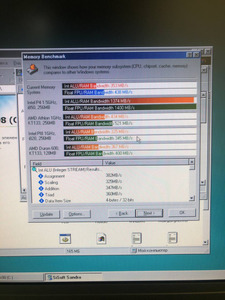Oetker wrote on 2022-08-31, 09:04:
lafoxxx wrote on 2022-08-31, 08:48:
What makes VIA Apollo better choice? Do people choose it because it has ISA+1.5 GB RAM limit (for people who just can't let ISA go, and think RAM is so important, especially in Win9x) ? Or is it just cheaper?
I think it's rather that it supports 133MHz FSB (and AGP4x) + ISA.
That. And it was much cheaper and available- both 22 years ago and today.
Thing to understand is that around 1999-2000 Intel was trying to push the market in a direction the market didn't want to go. Intel had chosen high-clock, high-bandwidth, high-latency Rambus RDRAM as the perfect pairing with its deeply pipelined bandwidth-hungry Netburst (P4) architecture. But first they needed there to be an RDRAM ecosystem out there. So during the GHz race, they dropped the i820 chipset as replacement for the i440BX for P3 Coppermine. It had all those nice features BX missed, such as AGP 4x, in-spec 133MHz FSB, ATA-66/100, faster-than-PCI interconnect between north and southbridge. Oh, and it supported RDRAM, not SDRAM.
Three problems:
1) RDRAM's high bandwidth wasn't needed for P3, but it was sensitive to its high latency. So i820 with PC800 RDRAM didn't manage to outperform i440BX with SDRAM.
2) RDRAM was viciously expensive, both due to royalties to Rambus and simply low volume, high cost production. Cost-cutting with PC600 RDRAM was worse: terrible performance and still twice as expensive as SDRAM.
3) Bugs, bugs and more bugs. Google "Caminogate" and "MTH issue".
Consequence: chipset arrived too late, and nobody really trusted it when it did. Meanwhile Via upgraded their awful ApolloPro133 to a quite acceptable ApolloPro133A. It basically offered all the features of the i820, but substituted a (slow) PC133 SDRAM interface instead of RDRAM. PCI performance was bad (and there were compatibility issues with the 686B chipset), there was driver hell with the 4-in-1 drivers (although to be fair, i820 Intel Application Accelerator drivers also took a while to get perfectly stable). But it was available in volume, it wasn't fundamentally flawed and it was cheap. Apart from these two, there were basically no alternatives in consumer space for high-end P3 systems in 2000.
So with a late P3 in 2000 you had four choices:
- stick with i440BX for good price and best performance on same FSB, accept max 100MHz FSB
- stick with i440BX for good price and best performance, attempt to OC your motherboard to 133MHz FSB
- sell a kidney and go for i820 with PC800 RDRAM
- accept a small performance hit (but smaller than PC600 RDRAM or 100MHz FSB) and go for cheap ApolloPro133a.
Unsurprisingly, most people went for the fourth option. So back then far more ApolloPro133A was sold, and that means today boards with that chipset are also the most plentiful. By 2001 there were more options, but by then the high-end crowd was buying Athlon Thunderbirds and P4s, so you don't see many ApolloPro266 or SiS635 boards. You do see quite a few i815 boards, but Intel intentionally limited it so as not to compete with i820 and P4 - in the day no one really cared about the 512MB RAM limit, these days people do. And the lack of ISA is of course of retro relevance, although to be honest, that's just being anachronistic. I can only think of one case in 2001 someone thought he needed ISA (for a Terratec EWS64XL sound card for semi-pro use), and he regretted it due to non-functional Win2k driver support. ISA was not a relevant consideration for most people doing high-end late P3 builds at the time.


